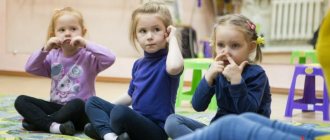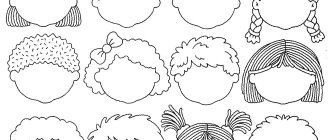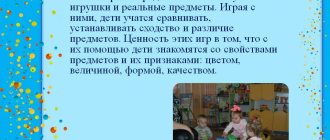Didactic games - concept and types
Didactic games for children are educational games, the rules and course of which are determined by the teacher and allow you to solve certain educational tasks: developing memory, expanding the child’s horizons, teaching new skills, replenishing vocabulary, etc.
Such games are strictly structured, have a main didactic goal, game rules and actions, a plot, a possible division of roles, and a required result are defined for children. One of the main components is the use of didactic materials.
It is by this criterion that the main classification of educational games is made:
- Games with objects. The main teaching material is various objects, these can be toys, special figures of different geometric shapes and colors, natural materials (vegetables, fruits, pine cones, leaves, flowers). Children's learning occurs due to the fact that in the process of play they determine the colors, shapes, purpose of objects, compare them by different properties, and get acquainted with nature. Such games are most suitable for young children, as they easily allow the child to be captivated.
- Board games . Here the main didactic material is pre-prepared printed materials for the game. These are, for example, thematic cards with drawings and figures, and the teacher can use them in various games, based on what goal he is pursuing. This type of game also includes lotto and dominoes. These games are suitable for children of all ages.
- Word games. The main role in such games is given to the teacher, who gives oral tasks for children. They may involve precise answers (for example, to riddles) or give the child the opportunity to show imagination and creativity.
Learning the basics of mathematics
Didactic games in mathematics allow you to consolidate previously acquired knowledge and learn new concepts. Knowledge of numbers and simple mathematical operations helps to begin solving problems with 1 or 2 steps. Solving mathematical problems develops thinking and intellectual abilities. Parents can conduct such activities in a playful way at home, using children's lotto or domino cards.
“Which number is missing.” The task is to consolidate ordinal counting in memory.
The teacher draws numbers on the board or attaches cards to them, but one number or several are missing. The baby must name the missing number, take a card from the table where it is depicted, and show it to everyone.
"More or less". Preschoolers must memorize the meaning of the concepts “more” or “less.” To do this, the child is asked to name a number that is greater or less than the number written on the board.
"Magic bag" The task is to consolidate knowledge about geometric shapes in memory. The children take turns taking a figure out of the bag by touch and describing it.
"Orientation in space." The preschooler must correctly navigate in space, understand the meaning of the terms: behind, side, left, right, below, above. You can offer to find a comfortable place for the doll. Place it in the middle, then move it back. Park the car behind.
Card index of didactic games for the younger group of kindergarten.
“Who has what place”:
- Target. To strengthen children’s understanding of the positions “in front”, “behind”, “right”, “left”, and to develop their attention.
- Progress of the game. The teacher calls the children to him one by one and asks them to take a certain place in relation to each other. For example, he says: “Lesha stands next to me. Sasha stand so that Nika is in front of you. Nikita, stand in front of Alice so that she is behind you.” When all the children come up, the teacher asks each child to say who is in front and behind. Then they ask the guys to turn right and left and say which of the guys occupies what position. Over time, children will learn to quickly identify locations.
"Who's Whose Cub":
- Target . Development of a child’s horizons, replenishment of vocabulary.
- Progress of the game. The teacher prepares two groups of cards, in the first - cards with images of domestic animals, in the second - their cubs. The child is asked to match the cards and name all the animals (for example, chicken - chick, horse - foal, etc.).
"Animals":
- Target. Expanding children's horizons.
- Progress of the game. Pictures of animals are prepared for children. Children determine whether the animal is domestic or wild and say where it lives.
Knowledge of ecology
All human life is surrounded by the living world, plants, animals. The child must understand the importance of maintaining ecological balance in nature, take care of animals and plants, and not harm them. Didactic games on ecology for children 5-6 years old introduce preschool children to the world around them, develop vocabulary, and cultivate hard work, kindness, and attentiveness.
Ecology classes can be conducted during walks or indoors, especially in bad, rainy or frosty weather. Before each lesson, the teacher talks about the subject of the lesson. For example, the theme is autumn. The teacher tells when autumn comes, what external signs are: leaves turn yellow, leaves fall, birds fly away to warmer regions, and the like. After which a didactic lesson is conducted in a playful way.
"Guess the time of year." The goal is to provide an understanding of the signs corresponding to the seasons. To consolidate in memory the characteristic features of summer, autumn, winter and spring. Development of auditory attention. Ability to formulate and express thoughts.
Actions. The teacher names weather and natural phenomena. For example, it began to snow, a blizzard swept the street, a snowdrop blossomed, a bunny changed the color of its fur coat. Preschoolers must highlight the odd ones out, name the time of year and justify their choice.
“What grows where?” The goal is to introduce kids to the plant world and places where different plants grow.
Preparation. The teacher talks about trees and shrubs, where and in what area they grow, and shows pictures.
Actions. The children stand in a semicircle, facing the teacher. The teacher shows a picture of a plant and says: “This is a strawberry, it grows here.” If the kids agree, they jump in place. The teacher shows a card with a pineapple and says that it is a pineapple, it grows in the north. If the restless people don’t agree, they stand and wave their hands: no, that’s not true.
"Birds, animals, fish." The goal is to provide knowledge about the species concept, to teach how to distinguish objects into groups.
Preparation. The task is performed in a playful way, using a ball or a small toy.
Actions. Preschool children stand in a circle, facing each other. The host starts the game. Throws the ball and says it's a fish. The child who caught the ball must name the fish, for example, pike, crucian carp, and throw the ball to his neighbor. When a preschooler throws a ball, he sets a task: to name a representative of fish, birds or animals. The one who catches the ball must give the correct answer.
"Guess what's hidden." The goal is to teach how to identify the characteristic features of an object and recognize it by description.
The presenter covers the apple, banana or carrot with a napkin. Invites you to guess what is hidden based on the description. Fidgets can ask leading questions. The first one to name the hidden object wins.
Didactic games for learning colors for young children
"Fix the car":
- Target. Develop children's ability to match objects by their color.
- Progress of the game. The teacher prepares flat models of cars from cardboard of different colors and separately suitable wheels (circles). Children are invited to look at the cars, determine what color they are and select the missing wheels of the same color for each.
"Alternation":
- Target. Strengthen children's ability to distinguish colors from each other.
- Progress of the game. There are several variants of this game. Children may be asked to string beads, or decorate them so that the beads alternate in a given sequence of colors.
"Find a friend":
- Target. Teach children to match different objects by color.
- Progress of the game. Toys of different colors are prepared in a bag. And in front of the child they place pictures of various objects of the same colors. The child’s task is to take the toy out of the bag and find a “friend” for it among the cards.
Sensory perception
Didactic sensory games are aimed at developing visual and tactile perception. Before conducting play activities related to sensory sensations, the teacher explains to preschool children what geometric shapes are and how they differ from each other.
Kids get acquainted with such materials as wood, metal, glass, plastic. The fidgets, together with the teacher, find the features of each material. For example, glass is fragile and can break. The wood is warm, the metal is cold to the touch.
"Make no mistake." The goal is to teach kids to group objects by shape and material. To consolidate in the child’s memory the knowledge and understanding of such concepts as soft, hard, smooth, rough, shiny, matte in color. The child must distinguish a large object from a small one and consolidate the concepts of geometric shapes.
Actions. The teacher divides the kids into several teams, optimally 4 teams. For each group, a box or basket is placed on the floor, onto which a picture with an object made of a certain material is attached. For example, metal scissors, a soft toy, a rubber ball, a plastic cube.
The teacher repeats once again with the preschool children how one material differs from another, after which he gives the task to the teams. Each group must find and collect in their box as many items as possible from the material shown in the picture. The team that collects the most items the fastest wins.
You can change the conditions of the gameplay, offer to collect round, square, triangular objects.
"Air balloons". The goal is to give the concept of spectrum, to consolidate the colors of the spectrum in memory: red, orange, yellow, green, blue and violet.
Actions. Each preschooler has a picture with multi-colored balls in front of him. You need to find and tie a thread of the same color.
Card index of didactic games for middle groups of kindergarten
"Truth-fiction":
- Target. Development of children's reaction speed to a task.
- Progress of the game. For each throw of the ball, the teacher names word combinations, true and fictitious. For example, rain in summer, a flying rhinoceros. Children must distinguish fact from fiction.
"Elements":
- Target. Improve children's knowledge about the natural environment.
- Progress of the game. The teacher throws the ball and says the words: “air”, “earth” or “water”. The child who caught the ball says who might live there.
"What's extra":
- Target. Development of the ability to compare objects by properties.
- Progress of the game. Children are given 4 pictures in turn; they need to find one extra one among them and explain their choice.
Card index of didactic games for older groups of kindergarten
“Come up with a description”:
- Target. Teach children to identify the most characteristic properties for each object.
- Progress of the game. The children take turns playing. Each child describes one object from the room, without naming: what it is for, what it looks like, who uses it. The other children's task is to guess what it is.
“Such a different sport”:
- Target. To foster interest in sports in children.
- Progress of the game. Children are given cards with sports scenes: football, basketball, swimming and pictures of sports equipment for these games. The child’s task is to find a suitable item for each sport.
“Come up with a drawing”:
- Target. Develop children's creative abilities.
- Progress of the game. Children are given images of geometric shapes on sheets of paper. They need to add some details to make interesting drawings, for example, draw a TV from a rectangle, a sun from a circle, etc.
Traffic Laws
The study of traffic rules in preschool institutions is given special importance. Knowing and following the rules of behavior on the road helps protect the life and health of preschoolers.
Acquaintance with road rules begins in a playful way with an acquaintance with the colors of traffic lights.
"Traffic light". The goal is to teach the rules of safe crossing of streets and intersections. Learn what the traffic light colors mean.
Preparation. The teacher shows a picture of a traffic light and explains the meaning of each color. He tells you how to cross the road correctly, what a zebra crossing is, whether you need to let a car pass, and how to check that there is no danger on the road. Children repeat and retell what they remember.
A model of a road with an intersection, where there is a roadway and a sidewalk, is being prepared. Figures of pedestrians are cut out of cardboard and painted. Car figures are made in the same way. Instead of cardboard crafts, you can use toy models of cars and small dolls.
Actions. One child places cars and dolls on a model road. Turns on the traffic light and changes colors one by one. The second kid guides pedestrians across the road and helps cars pass. After completing the gameplay, preschoolers change roles. When summing up, the number of errors is taken into account. The little one who makes the fewest mistakes wins.
To reinforce the educational material, you can conduct practical classes in the playroom or in the courtyard of a preschool institution. If the game activity is held indoors, then you can make a road, sidewalk and pedestrian zebra crossing using colored ribbons. On the street, all the details of the crossing can be drawn with white chalk.
There are board game sets for learning the rules of the road. They contain a playing field, cubes, chips, figures of cars and pedestrians, as well as road signs on stands. Several people can take part in the game. Preschoolers take turns throwing the dice, taking as many steps as the dice shows. If there is a red traffic light on the playing field, the pedestrian skips a turn, a green light continues moving.
“Connect parts of signs into a whole.” Kids love to collect puzzles - images of something cut into pieces. Give each child a cut-out picture of a road sign to assemble. When the fidget has collected a road sign, he raises his hand. Tells his group mates what sign he has collected and what this road sign means.
Didactic games for the development of coherent speech in preschoolers
Coherent speech is the ability to logically and consistently express your thoughts or figuratively describe a situation, while observing all grammatical rules.
It is especially important to develop these skills for children of senior preschool age and when preparing for school, since there is a need for practical communication in different life situations and preparation for reading and writing is underway.
Educational games aimed at children expressing their points of view, describing objects and situations, retelling or composing short stories help develop coherent speech.
“Describe the picture”:
- Target . Development of skills to describe paintings of different genre styles, expanding the child’s horizons.
- Progress of the game. Reproductions of famous works of fine art are prepared for children. The teacher names the author of the picture and its title, and the child must describe what he sees. If it is a landscape or still life, the child develops descriptive storytelling skills; he must define all parts of the picture and express his attitude towards them. If the picture is of a different genre, the child must come up with what the plot could be if the picture in front of him came to life, imagine himself in the place of the characters and also evaluate his feelings.
"Make up a story":
- Target. Development of coherent speech in children, thinking and imagination.
- Progress of the game. The teacher begins the story, 2-3 sentences, and the children’s task is to come up with an interesting continuation and ending. The task can be completed one at a time or by all children together.
Speech development
Any didactic game for a 5-6 year old child is primarily aimed at expanding vocabulary, as well as developing speech. Coherent, logically structured speech is an indicator of the speech development of a preschooler. After 5 years, the baby begins to control his speech. In a child’s conversation, not only simple but also complex sentences appear.
Children distinguish and identify groups of sounds in words. Speech becomes more expressive, the preschooler uses intonation correctly. Can emphasize a sad or cheerful mood with his voice. Preschoolers understand and are able to regulate the volume of their voice and its tempo. They can speak in a whisper, quickly or slowly.
Didactic games for speech development teach you to coherently express your thoughts, build a correct dialogue, and teach you to pronounce sounds correctly. In speech development games, special attention is paid to the formation of speech and phonetic hearing of a preschooler. The teacher works with sounds and letters in a playful way, and teaches how to correctly formulate and pronounce entire sentences.
"Broken phone". The goal is to develop auditory perception, memory, ability to work in a team, honesty and goodwill.
Rules. The child whispers the word to the neighbor so that other children do not hear. If the child incorrectly conveyed the word, that is, damaged the phone, this child must sit in the last chair.
Actions. Preschoolers sit side by side on chairs, forming a chain. The first child quietly speaks a word into the neighbor’s ear, who passes it on. The kid who sits last names the word he hears. If the phone works, the word was transmitted correctly. If the phone breaks down, they ask along the chain who heard what word, and find where it was transmitted incorrectly.
"Solve the puzzle." The goal is to teach how to divide words into syllables, be able to highlight the first syllable, and form words.
Rules. In each word presented, highlight the first syllable and create a new word.
Actions. Find the word that is hidden on the card. Each preschooler receives a picture showing 3 drawings. You need to name the words, select 1 syllable from each word. Make a hidden word from the received syllables. For example, there are pictures with the following words:
- sun, shovel, car (straw);
- house, rose, guitar (roads);
- wolf, chamomile, tank (gate);
- owl, button accordion, cabbage (dog).
“Say the opposite.” The goal is to give the concept of antonyms and consolidate it in memory. Expansion of vocabulary, formation of correct speech. Developing mindfulness.
Rules. For each word, choose the opposite meaning. For example, big - small, up - down, far - close. You can use verbs: wet - dry.
Actions. Preschool children sit on chairs in a circle. The teacher takes the ball, says the first word and throws the ball. The kid catches the ball, says a word with the opposite meaning, and throws the ball to another child.
"One is many." Goal: The preschooler must learn to form a plural from a singular noun. Expand your vocabulary.
Rules. The teacher says the word in the singular, the child must form the plural.
Actions. The teacher throws the ball and says the word in the singular. The preschooler returns the ball, while naming the plural.
“Say more words.” The goal is to teach how to describe an animal not only by external signs, but also by traits and character traits.
Actions. The teacher suggests taking a picture of any animal and describing it. For example, a cat is fluffy, affectionate, loves milk, meows gently. The more words and definitions the fidget comes up with, the better.
DIY didactic game
The main advantage of didactic games is the ability to come up with a game even at home, for children of all ages, starting from 2 to 3 years old.
Didactic games for children 2 - 3 years old.
“Find thorns for the hedgehog”:
- Target. Development of fine motor skills of the hands.
- Progress of the game. It is necessary to cut out shapes in the shape of hedgehogs from multi-colored paper, and prepare clothespins of the same colors. Children must attach several suitable clothespins to each hedgehog’s back and name what color the hedgehog is.
"Matryoshka":
- Target. Teach children to sort objects by size.
- Progress of the game. Prepare cards for children with matryoshka dolls of different sizes, which can be hand-drawn. Children are asked to line up all the nesting dolls from smallest to largest and vice versa.
Didactic games for children 4 – 5 years old.
"What grows on a branch":
- Target . Test and improve children's knowledge of botany.
- Progress of the game. Prepare dried or picked leaves and fruits from different trees and let the children examine them. Then the children select a suitable fruit for each leaf and tell which plant they belong to.
“Guess the geometric shape”:
- Target. Development of fine motor skills of the hands.
- Progress of the game. Buttons are glued or sewn onto cardboard sheets to create geometric shapes. A child with his eyes closed should understand by touch what kind of figure is depicted. To complicate the task, you can depict numbers and letters.
Didactic games for children 5 – 6 years old.
“Make a whole from parts”:
- Target. Develop children's creative abilities.
- Progress of the game. The child is offered flat cards - in the form of various geometric shapes. The child’s task is to assemble larger geometric shapes from individual parts. You can do it for a while - who will make more different shapes, or for the result - who will have a more beautiful pattern of geometric shapes.
"Come up with a word":
- Target. Learning the alphabet, developing thinking.
- Progress of the game. Prepare cards for the child depicting letters of the Russian alphabet. The child must take cards in random order and name the words that he knows that begin with this letter.
Didactic games for children are useful and necessary. With their help, you can develop a child’s attention, thinking, memory, speech from an early age (2-3 years old) and do this in a playful, unobtrusive form that is interesting for the child.
Article design: Svetlana Ovsyanikova
Developing memory
Didactic games for 5-year-old preschoolers help develop attentiveness and memory, which is very useful for school. Almost all information at school is received orally, this is especially true for first-graders, when children do not yet know how to write quickly and a lot. Developed attention and memory will help consolidate new knowledge and remember the information received.
All tasks to consolidate memory and develop attention are carried out with toys and small objects. Sometimes the child fails to fulfill the conditions of the task, since voluntary memory is just beginning the process of formation. If tasks involve finding hidden toys or rearranging them, you can suggest using a “pointing gesture” with your finger before starting.
The preschooler points his finger at all the toys one by one and describes their appearance. The baby can pick up the toy and touch it for better memory. For the first lessons, you should not offer games with a large number of elements or details: a confused child may refuse to play and burst into tears.
"What disappeared." A leader is selected, at first it can be a teacher. When the children become familiar with the rules, each of them can try themselves as a leader. 3 - 4 small toys are placed on the table. The presenter suggests remembering what objects are on the table and turning away. When the preschoolers have turned away, the leader removes one toy. Players must remember which toy is missing. You can add a competitive element to the gameplay. Whoever remembers correctly first gets a chip or token.
"What changed". The presenter chooses. Several toys are placed on the table. Fidgets must remember which toys are placed and how. When the preschoolers turn away, the leader rearranges the toys and changes their places. The winner is the one who is the first to correctly say which objects were moved and where their original place was.
"Find the difference." 2 pictures are placed in front of each child. You need to find out how they differ. Alternatively, the picture may show hidden kittens or birds that need to be found in the bushes, behind trees or a fence.
"Similar or dissimilar objects." The goal is to develop attentiveness, observation, and teach how to find similarities in color, shape, size, and material.
Rules. The kid on whom the counting stopped answers answers. You need to find 2 objects with identical properties and prove your statement.
Actions. At the teacher’s signal, all preschool children take 2 objects with similar properties from the playroom.
It is necessary to maintain the level of difficulty of tasks, moving from easy to difficult gradually. Exercises that are too easy or difficult will not arouse the child's interest.








